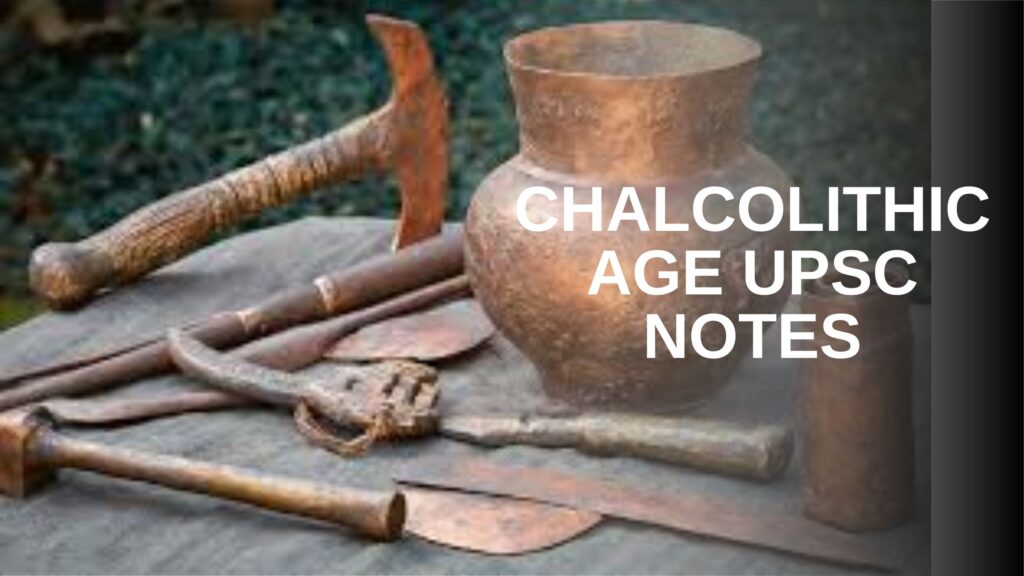The Chalcolithic Age, derived from the Greek words khalkos (copper) and lithos (stone), represents a significant transition in human civilization. This period, dating from approximately 6500 years ago to around 1000 BCE, marks the introduction of metalworking technology, where people began using copper along with stone tools.
The Emergence of the Chalcolithic Age
The Chalcolithic Age is often referred to as the Copper Age, bridging the gap between the Stone Age and the Bronze Age. It saw advancements in agriculture, metallurgy, settlement patterns, and social organization. The earliest evidence of this period in the Indian subcontinent comes from sites like Kalibangan, Rajasthan, which benefited from nearby copper mines such as Khetri.
Though running parallel to the Harappan Civilization, Chalcolithic cultures remained distinct due to the absence of tin, preventing them from developing a full-fledged Bronze Age culture. However, their innovations in tools, pottery, and settlements made them remarkable in their own right.
Key Features of the Chalcolithic Age
- Agriculture – Cultivation of rice, wheat, pulses, bajra, and ragi began, alongside the earliest evidence of cotton use.
- Animal Domestication – People domesticated cows, sheep, goats, buffalo, and dogs.
- Settlements – Communities lived in mud-brick houses in rural settlements.
- Metallurgy & Tools – Copper was used for tools, weapons, and ornaments.
- Pottery – Black-and-red pottery and ochre-colored pottery were common.
- Religion – The discovery of earth goddess figurines suggests early religious practices.
- Jewelry & Ornaments – Evidence from excavations indicates a fondness for jewelry.
Major Chalcolithic Cultures in India

1. Ahar Culture (Banas Culture) (1950-1700 BCE)
- Location: Udaipur, Rajasthan
- Key Sites: Gilund, Balathal, Ojiyana
- Houses: Mud-brick and stone structures
- Industries: Mass production of ceramics and metalwork
2. Kayatha Culture (2450-2000 BCE)
- Location: Chambal River, Madhya Pradesh
- Houses: Mud-plastered floors
- Industries: Specialized blade industry (chalcedony blades)
- Economy: Farming, stock raising, and hunting-fishing
3. Malwa Culture (1700-1400 BCE)
- Location: Narmada River basin
- Key Sites: Nagda, Kayatha, Eran
- Houses: Mud-brick houses with fired bricks (Nagda site)
- Industries: Large ceramic production
- Religion: Terracotta female figurines and sacrificial altars
4. Jorwe Culture (1700-700 BCE)
- Location: Maharashtra
- Key Sites: Jorwe, Daimabad, Inamgaon
- Houses: Early phase – rectangular; Later phase – circular, semi-nomadic
- Agriculture: Crop rotation, cultivation of wheat, barley, rice, lentils
- Industries: Stone blade industry and lime-making
- Distinct Feature: Urn burials with ankle-chopped skeletons
5. Ochre-Coloured Pottery (OCP) Culture (2600-900 BCE)
- Location: Uttar Pradesh, Rajasthan, Punjab, Haryana
- Key Sites: Bisauli, Rajpur Parsu, Bahadarabad, Manpur
- Pottery: Highly fragile ochre-colored ceramics
- Distinct Feature: Similarities with Late Harappan and Vedic cultures
Transition to the Bronze and Iron Age
In areas where tin was available, the Chalcolithic Age transformed into the Bronze Age. However, in regions without tin, the Chalcolithic cultures directly evolved into the Iron Age. The Painted Grey Ware (PGW) culture in North India is often associated with the advent of the Iron Age, though initially, copper remained more prevalent than iron.
FAQ Related to the Chalcolithic Age
1. Which age is known as the Chalcolithic Age?
The Chalcolithic Age (Copper Age) spans from 6500 years ago to around 1000 BCE. It is the era following the Stone Age, where early humans used both stone and copper tools.
2. What are the main features of the Chalcolithic Age?
Key features include copper tools, agriculture, small rural settlements, domestication of animals, and pottery-making.
3. Who discovered the Chalcolithic Age in India?
Different archaeologists excavated various Chalcolithic sites across India, but no single individual is credited with the discovery of the entire age.
4. What time period does the Chalcolithic Era cover?
The Chalcolithic Era in India generally dates from 4500 BCE to 1000 BCE, overlapping with the Indus Valley Civilization.
5. What is the difference between the Chalcolithic Age and the Mesolithic Age?
- Chalcolithic Age – Marked by the use of copper, settled agriculture, and early metallurgy.
- Mesolithic Age – Characterized by microlithic tools, a hunter-gatherer lifestyle, and the gradual transition to farming.


